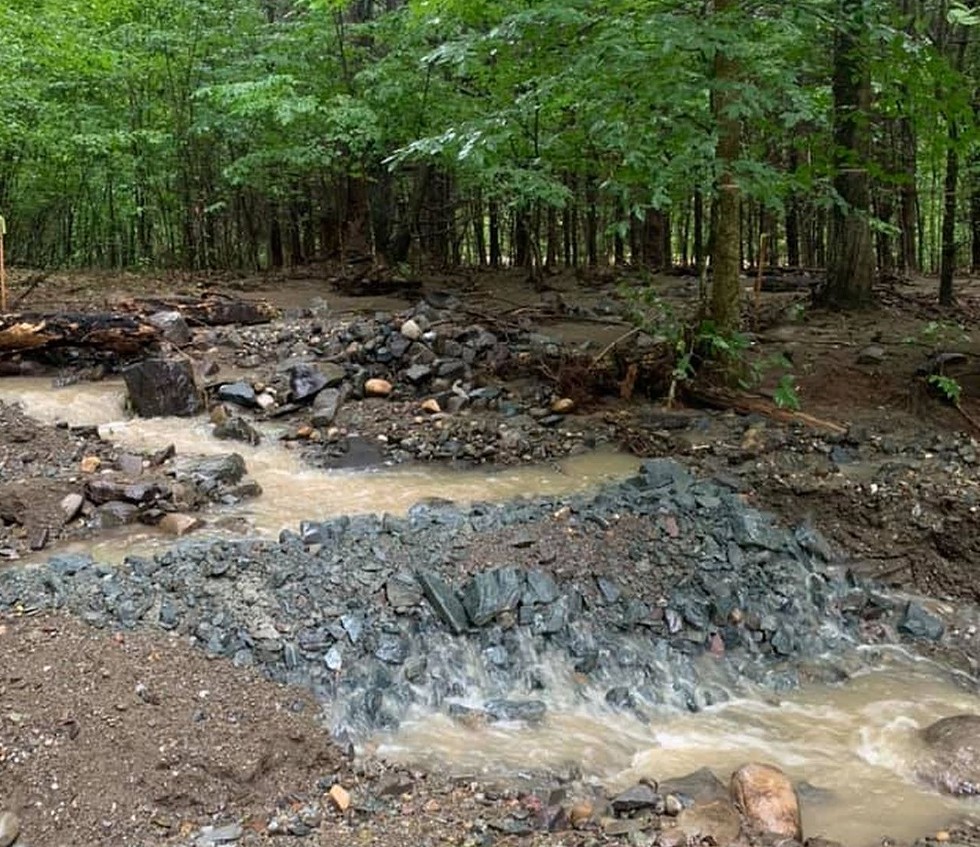Before the advent of major environmental regulation in the seventies and eighties, the dumping of dangerous chemicals that could persist for decades was common across the US. It took the horrors of Love Canal—a community in western New York built atop an oozing dump of buried toxic waste—to shake the nation from complacency about the dangers of dumping.
The passage of the Comprehensive Environmental Response, Compensation, and Liability Act in 1980 set up a trust fund, dubbed “Superfund,” to clean up abandoned waste sites. More than forty years after the law’s passage, there are still more than a dozen active Superfund sites in the Hudson Valley region that hold dangerous levels of contamination, ranging from PCBs to solvents to dry cleaning chemicals.
Today, a new threat is taking aim at the old sites: Climate change.
In the Hudson Valley and Catskills region, as well as across New York State generally, floods are the greatest risk posed by accelerating climate change. According to John Senn, a public affairs specialist with the New York City region of the Environmental Protection Agency, climate change is expected to take the form of “more frequent and more intense storm events, resulting in increased risk of flooding.”
As floods increase in number and intensity, they are complicating the cleanup of old Superfund sites, and threatening efforts to contain the spread of toxins at some Hudson Valley sites.
For some sites, the spread of contamination by increased flooding is a risk that communities are seeking to prepare for. At others, it is already happening. In 2021, extreme rainfall caused severe flooding along Little Thunder Brook, downstream from a toxic Superfund site in Rensselaer County, and spread PCB contamination to new areas.
At some sites, the risk posed by climate change is not yet fully known. While federal and New York state agencies agree that flood events are expected to become more frequent and severe each year, the process to assess the effects of climate change on Superfund sites can take up to five years.
In the steep narrow valleys of the Hudson Valley, flash floods can happen with little warning, and wreak damage quickly. But the process of assessing how contaminants might migrate in a flood event is slow. “That would go hand-in-hand with the implementation of the overall site remedy; a process that generally requires several years,” says Jeff Wernick, a spokesperson for the New York State Department of Environmental Conservation.
Every Superfund site that still has dangerous levels of contamination gets a review of its ongoing cleanup plan every five years by the EPA. As part of this process, the EPA assesses the effects of climate change on Superfund sites. Public outreach for comment is part of this process.
Regardless of whether or not flooding has interfered with a cleanup, Senn says the Superfund program requires a re-evaluation every five years to see if site-specific plans are working to protect human health and the environment.
Evaluating the future impact of climate change is a difficult task, made more so by the fact that some New York State flood maps are as much as 40 years out of date. “Flood maps and studies are not updated frequently enough,” a DEC guide to managing flood risk states.
In the summer of 2021, historic flooding hit multiple areas across New York State. In August, flooding from Tropical Storm Henri soaked the Northeast and broke rainfall records in New York City. Less than two weeks later, the remnants of Hurricane Ida lashed New York, shattering Henri’s rainfall records, killing at least 16 people, and causing flash floods, power outages, and the closure of state highways and public transportation. In the wake of the storm, Governor Kathy Hochul requested a federal emergency declaration for 14 counties, ranging from the New York metropolitan area up through the mid-Hudson Valley.
At several local Superfund sites, flooding from Henri and Ida has complicated ongoing efforts to restore the sites and protect surrounding communities.
• Read: 'Worse Than Irene’: The Toxic Aftermath of a Storm in Rensselaer County
Dewey Loeffel Landfill Superfund Site
When Henri hit the region in mid-August, Rensselaer County was still dealing with its own major flooding event from the previous month—a storm that local officials called “worse than Irene,” in comparison to the torrential rains of August, 2011. A state of emergency was declared in Rensselaer County after a fast-moving storm dropped almost five inches of rain, washing out roads in the town of Nassau.
The repeated flooding disturbed old contaminants and sent them flowing downstream. On Mead Road in Nassau, Little Thunder Brook—a small tributary with high concentrations of PCBs in the sediment from the nearby Dewey Loeffel Landfill Superfund site—experienced flooding and shifts in flow, washing away sections of the stream bank with contaminated soil and sending them downstream toward the Valatie Kill, which flows into Nassau Lake and eventually the Hudson River.
According to the EPA, the toxins disturbed by the storm were produced in the fifties and sixties by General Electric and SI Group, who contracted with Dewey Loeffel to dump more than 46,000 tons of industrial hazardous wastes, carcinogens, and PCBs into a natural lagoon turned dumping ground. The total amount of hazardous waste at the Dewey Loeffel site was twice the volume of what was buried at the infamous Love Canal site.
In the decades since dumping stopped at Dewey Loeffel, the contaminants have migrated out and traveled deep in the soil on the banks of the brook, and are still found today.
Under the oversight of the EPA, General Electric and SI Group are now conducting a remedial investigation and feasibility study for Little Thunder Brook, the landfill, groundwater and other water bodies connected to the site. The companies are paying for the EPA’s costs to oversee the current cleanup.
Part of the study will involve looking at how flash floods impact the site. A hydraulic modeling evaluation will be used to evaluate “high-intensity, short-duration events like the July 2021 storm event, and how those events influence the water elevation, flow rate, and flow velocity in Little Thunder Brook,” says EPA spokesperson Larisa Romanowski. “The results of the hydraulic modeling evaluation are expected to provide information to help ensure that the remedy selected, designed and implemented for Little Thunder Brook will be resilient to extreme weather events in the future.”
Along with PCBs, metals, pesticides, semivolatile and volatile organic compounds, additional toxins are still being discovered. In 2014, the cleanup discovered 1,4 dioxane at the site, a chemical considered by the EPA to be a “likely human carcinogen.” Nassau Town Supervisor Dave Fleming says that the latest testing by the EPA “indicates 1,4-dioxane levels over 100 times the acceptable limits” in groundwater close to the landfill site and to Little Thunder Brook.
The Rensselaer County Legislature passed a county law in 2017 limiting the discharge of 1,4-dioxane from Superfund site properties that are owned by the county to a maximum level of 0.35 parts per billion. While there is no federal maximum contaminant level, the EPA has a nonbinding health advisory level for screening 1,4 dioxane in drinking wells and groundwater.
High levels of benzene in the same area of testing are also “concerning,” Fleming says. Until the toxins at the Loeffel Superfund site are no longer washing into the Valatie Kill and other local waterways, he says, “we have accomplished no effective remediation at this site.”
A water treatment plant at the Loeffel site takes contaminated groundwater extracted from the landfill, treats it to EPA acceptable levels, and discharges it downstream into the Valatie Kill, which flows through Nassau Lake, Kinderhook Lake, into the Kinderhook Creek, the Stockport Creek and ends in the Hudson River. Columbia County towns and villages downstream—including Kinderhook, Valatie and Stockport—have expressed concern over the years by this filtration method commonly used by the EPA.
Downstream from Loeffel, Contamination Still a Mystery
The Columbia County village of Valatie, home to about 1,800 people, lies just 13 miles downstream from the Loeffel site. This winter, elevated levels of PFOS (perfluorooctanesulfonic acid, one of a class of chemicals known as per- and polyfluoroalkyl substances, or PFAS) were discovered in the village’s public drinking water system. According to a letter sent to Valatie residents in February, PFOS was found in one of the village’s four drinking water wells at a PFOS level of 14 parts per trillion. That level is higher than New York State’s maximum contaminant level of 10 parts per trillion for PFOS in public drinking water systems, although the federal EPA sets a less stringent limit of 70 parts per trillion.
“We do not know where the contamination is coming from,” says Columbia County Environmental Health Director Magnolia McBroom. “We're waiting on preliminary plans from the engineering company employed by the village, outlining their treatment plan.” In the meantime, the village has taken the well with the elevated levels out of use, and is continuing to test the others.
In Valatie, seasonal runoff from the Kinderhook Creek has at times affected village wells. Another well in the village system was previously taken offline due to flooding concerns. The village is working toward a long term solution to lower PFOS levels in the affected well field, and is also working on developing a long-term strategy of permanent treatment, filtration, mitigation and well sampling.
Neither the state nor the village is investigating where the chemical is coming from, or whether it might be coming from the Loeffel site. “If the New York State Department of Environmental Conservation feels inclined to do so, they may look into finding the source of the contamination, but the state has not given us any indication that they will be trying to find the source,” says McBroom. “Our department will not be making any efforts to try and make that determination.”
Wappinger Creek Superfund Site
Like many other Hudson River tributaries, the Wappinger Creek has experienced an increase in flooding events in the past years.
The 41.7-mile-long creek flows from Thompson Pond to the Hudson River, and is the longest creek in Dutchess County. Added to the National Priorities List as a Superfund site in 2016, the Wappinger Creek Superfund site is in the tidal portion of the creek, near the Hudson. The site begins downstream of Wappingers Falls, extending about two miles where it merges with the Hudson River.
Ramapo Landfill Superfund Site
For more than 180 years, a local industrial park just downstream of Wappingers Falls sent wastes into the creek from different commercial activities, including manufactured gas plants, textile dyeing, bleaching, and metal plating. The Three Star Anodizing site, a site on the New York State Superfund list, was also located in the industrial park. EPA samples of creek sediments in the area show high levels of contamination, including mercury, lead, chromium, and polycyclic aromatic hydrocarbons.
Plans to address contamination at Wappinger Creek are still developing, according to Senn, who says that the EPA is weighing the “long-term resilience of the different alternatives with regard to expectations for flooding.” In 2023, the EPA plans to present a proposed cleanup plan to the community.
In large storm events, runoff can cause damage to the landfill cap at the Ramapo Landfill Superfund site, according to the EPA. Damage to the cap can flush contaminants into groundwater, or spread contaminated soil to nearby lakes, streams and wildlife. Flooding from Superstorm Sandy caused damage to the cap in 2012.
Landfill activities in the 1970s resulted in the contamination of groundwater with metals and volatile organic compounds, including wastes from a cosmetics company, a pharmaceutical company, and an automobile manufacturer. Other substances reportedly disposed of in the landfill include sewage sludge, municipal refuse, asbestos, construction and demolition debris, yard debris, paint sludge (presumably from the automotive plant) and liquid wastes from a paper company.
Flood Risk and Toxins: A National Problem
Of the 1,333 Superfund sites currently listed on the federal National Priorities List, 85 are located in New York.
The EPA does not consider every Superfund site in the Hudson Valley to be at risk of flooding. At sites such as the Haviland Complex, Hyde Park, Shenandoah Road Groundwater Contamination, East Fishkill, Hopewell Precision, Hopewell Junction, and Saint-Gobain Performance Plastics in Hoosick Falls, the EPA “has not identified the risk of increasing flooding as posing a threat to those cleanup actions,” says Senn.
But some scientists fear that more than half of the nation’s Superfund sites may be at risk. According to a 2020 study by the Union of Concerned Scientists, climate change is increasing the risks posed to vulnerable communities by old contamination.
“In our analysis, we find more than 800 Superfund sites would be at risk of extreme flooding under low rates of sea level rise within the next 20 years,” the study’s authors write. “These extreme floods could pose risks to ongoing remediation activities, lead to recontamination of areas considered clean, and affect the health of people living near these facilities in situations where contaminants are (or were) transported off site in flood waters.”


















